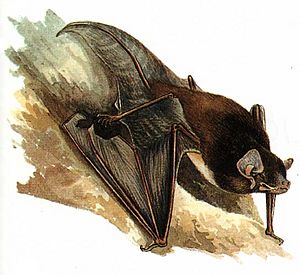Gould's long-eared bat facts for kids
Quick facts for kids Gould's long-eared bat |
|
|---|---|
 |
|
| Conservation status | |
| Scientific classification |
The Gould's long-eared bat (Nyctophilus gouldi) is a type of microbat found in Australia. These bats live in the southern parts of the country. You can find them in eastern Australia, from Queensland down to Victoria. There's also a smaller group living in the southwest of Western Australia.
Contents
Discovering Gould's Long-Eared Bat
This special bat was first described by a scientist named Robert Tomes in 1858. He studied bats sent to him by John Gould, a famous bird and animal artist. The first bat Tomes looked at came from Moreton Bay in Queensland.
The bat was named after John Gould because of his important contributions. Local Aboriginal people in the Southwest of Australia had their own names for these bats. For example, near Perth, they called them "bam-be," and near Albany, they were called "bar-ba-lon." These names were probably used for any small insect-eating bats in the area.
What Does It Look Like?
Gould's long-eared bats can be dark brown or dark gray on their backs. Their bellies are usually a lighter gray. They can grow up to 58 millimetres long. As their name suggests, their ears are very long, which is typical for bats in the Nyctophilus group.
Their size can vary depending on where they live. Bats from coastal areas are usually larger and heavier. Their forearm length, which is a common measurement for bats, ranges from 36 to 48 millimetres. They weigh between 5.2 and 16 grams. Their wings are wide and a bit short, which helps them fly slowly and turn easily.
The total length of their head and body is about 44 to 52 millimetres. Their tail is around 39 to 41 millimetres long. Their ears, from the base to the tip, measure 24 to 29 millimetres. When they are resting, their long ears can fold down. But when they get ready to fly, their ears stand up straight!
These bats have a unique T-shaped bump on their nose. This is a special feature that helps tell them apart from other similar bats.
Where They Live and What They Eat
Gould's long-eared bats are one of the most common bat species in Australia. They are very adaptable and can live in many different places. You can find them in wet forests, dry sclerophyll woodlands, and even along rivers in semi-dry areas.
These bats like to roost, or rest, in safe spots during the day. They often hide under loose tree bark or inside tree hollows. Sometimes, they even find shelter in old bird nests or buildings. They usually live in groups of up to 25 bats, but males sometimes prefer to rest alone.
In southern Australia, these bats will hibernate during the colder winter months, from April or May until September. This means they go into a deep sleep, using up their stored body fat to survive. They can stay in this sleepy state for up to eleven days at a time.
Gould's long-eared bats are insect eaters. They hunt both flying insects and those found on the ground. They usually come out later in the evening to hunt. They fly slowly and carefully, often hovering close to leaves or the ground. This helps them listen for and find their prey. They catch insects that are flying, or they snatch them right off leaves and the ground. Most of the time, they eat their captured insects while still flying!
Reproduction and Life Cycle
Female Gould's long-eared bats usually give birth between October and November. They typically have one or two babies at a time. The young bats are fed by their mothers for about six weeks. By January, the young bats are strong enough to start flying on their own.
Where to Find Them
You can find Gould's long-eared bats across a wide area of Australia. In the east, their range stretches from Cairns, Queensland down to the southeast corner of South Australia. There's also a separate group living in the high rainfall forests of Southwest Australia.
These bats prefer areas with forests and woodlands. Their range is limited by how far the open eucalypt woodlands extend inland. In inland areas, especially near the Great Dividing Range, they often live near river red gum trees (Eucalyptus camaldulensis), which grow along water courses.
In cities like Sydney, these bats often live in inner city areas or northern suburbs that are close to bushland reserves or parks. In Canberra, they enjoy the rich forest habitats around Lake Burley Griffin, the Australian National Botanic Gardens, and Black Mountain Nature Park. In Melbourne, they are common and found in many suitable habitats, especially near waterways with lots of ferns.
Images for kids
See also
 In Spanish: Nyctophilus gouldi para niños
In Spanish: Nyctophilus gouldi para niños



